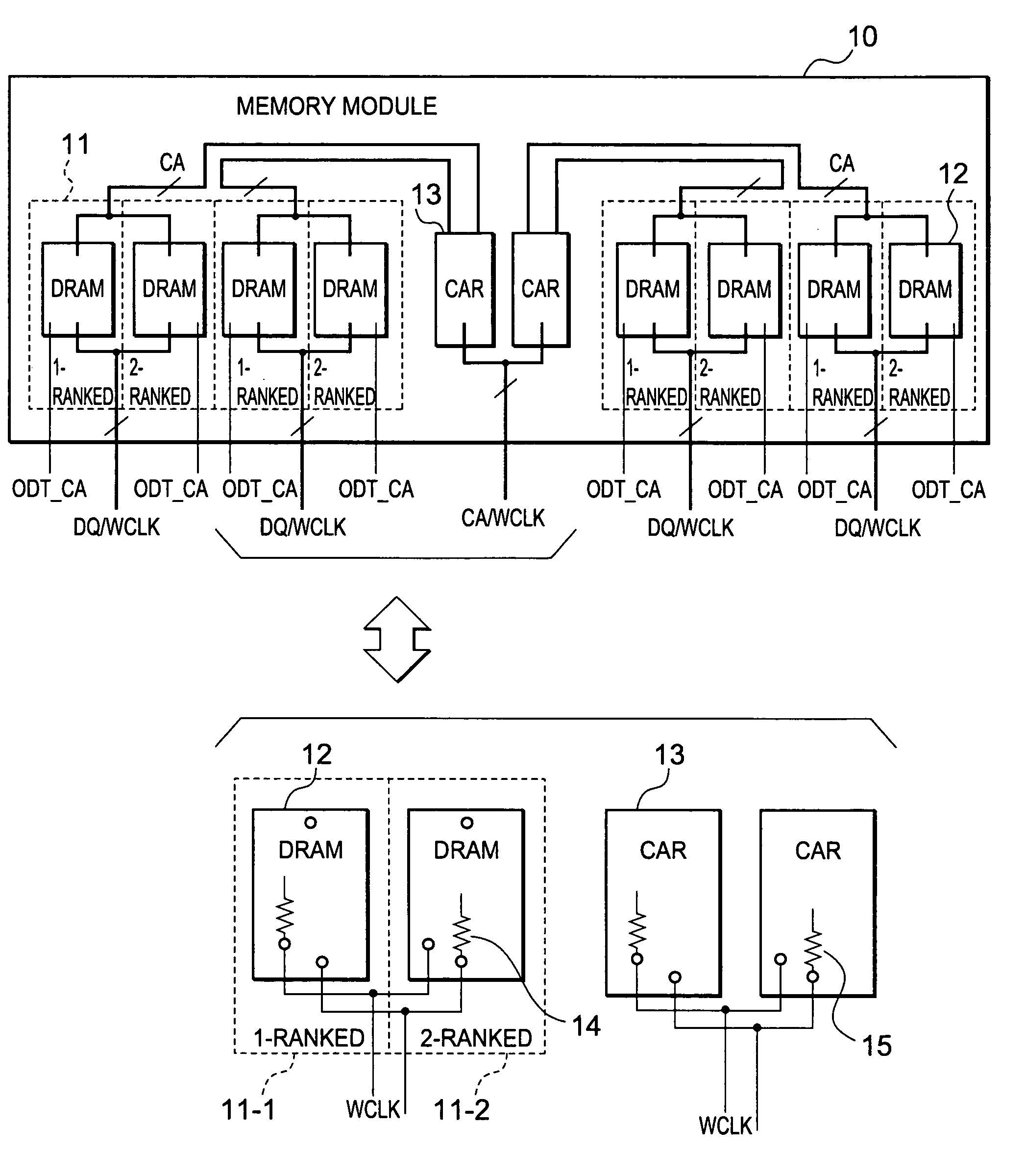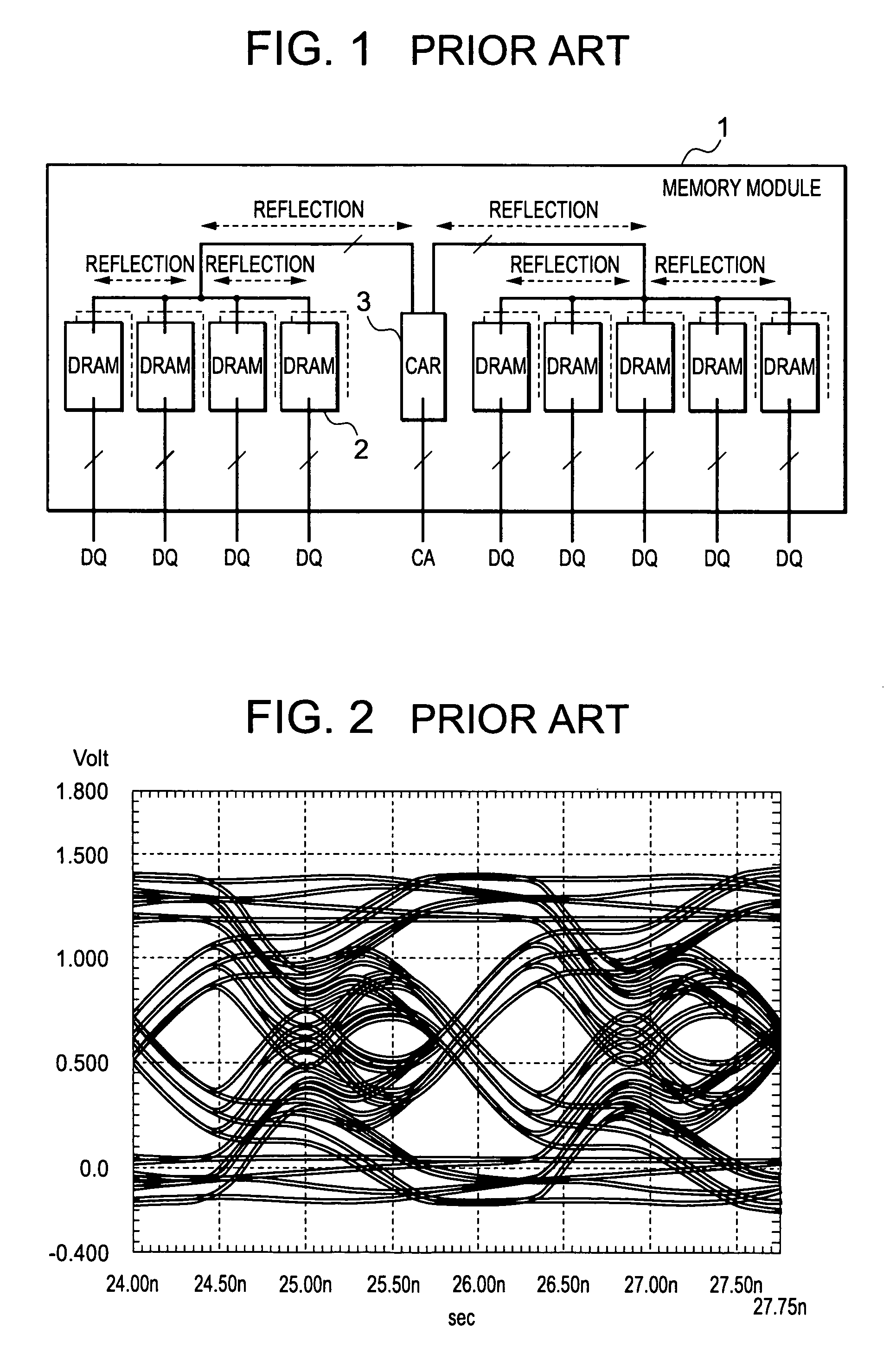Memory module, memory chip, and memory system
a memory module and memory chip technology, applied in the field of memory modules, can solve the problems of significant waveform distortion, increased time constant of signal reflection, and significant waveform distortion, and achieve the effect of memory capability with reliability and reducing waveform distortion
- Summary
- Abstract
- Description
- Claims
- Application Information
AI Technical Summary
Benefits of technology
Problems solved by technology
Method used
Image
Examples
first embodiment
[0055]FIG. 3 is a block wiring diagram illustrating the present invention. As shown in this drawing, a memory module 10 includes 11-1-ranked and 11-2-ranked devices that are accessible at the same time. These devices are sixteen dynamic random access memories (DRAMs) 12. These DRAMs 12 are divided into two groups formed on both faces of a module substrate and each of the two groups includes eight DRAMs 12. These eight DRAMs 12 are divided into four memory groups and each of the four memory groups includes two DRAMs. One of the two DRAMs is mounted on one face of the module substrate and the other is mounted on the other face thereof. These two DRAMs are commonly wired. Therefore, this drawing shows only eight DRAMs 12. That is to say, each of the memory groups is paired with the other memory group adjacent thereto. Further, the rank of one of each pair of the adjacent memory groups is different from that of the other.
[0056]Thus, according to this embodiment, one DRAM 12 on the top s...
second embodiment
[0084]the present invention will now be described with reference to FIGS. 14 to 19.
[0085]According to this embodiment, eighteen DRAMs 12 are used in a memory module 40, as shown in FIG. 14. That is to say, two DRAMs 12 are added to the DRAMs 12 of the first embodiment. These two added DRAMs 12 are stacked on a predetermined 1-ranked DRAM 12 and a predetermined 2-ranked DRAM 12 being adjacent thereto and paired therewith, whereby two units 41 of two DRAMs 12 stacked on each other are formed. One of the two units 41 of the stacked DRAMs 12 is provided on one face of the module substrate and a DRAM 12 is provided on the other face thereof so as to form a memory group. The other of the two units 41 of the stacked DRAMs 12 on one face of the module substrate and another DRAM 12 on the other face thereof also form another memory group. According to this configuration, active termination is performed in the DRAMs 12 on the other face of the module substrate. FIG. 16 shows simulation wavefo...
third embodiment
[0091]the present invention will now be described with reference FIG. 20. In this embodiment, eighteen DRAMs with ECC (error checking and correcting) capability different from the DRAMs shown in FIG. 14 are used.
[0092]As shown in this drawing, a memory module 70 includes a plurality of 71-ranked devices. These 71-ranked devices comprise nine DRAMs 72 on a top face of a module substrate and nine DRAMs 72 on an under face thereof. A fifth DRAM 72 on the top face, that is, the DRAM 72 at the center of the top face is 2-ranked. On the other hand, a fifth DRAM 72 on the under face, that is, the DRAM 72 at the center of the under face is 1-ranked. These first to ninth DRAMs 72 on the top face are designated by reference character A, and these first to ninth DRAMs 72 on the under face are designated by reference character B.
[0093]Subsequently, the DRAMs 1A, 1B, 3A, 3B, 5B, 6A, 6B, 8A, and 8B are 1-ranked. Further, the DRAMs 2A, 2B, 4A, 4B, 5A, 7A, 7B, 9A, and 9B are 2-ranked. Adjacent memo...
PUM
 Login to View More
Login to View More Abstract
Description
Claims
Application Information
 Login to View More
Login to View More - R&D
- Intellectual Property
- Life Sciences
- Materials
- Tech Scout
- Unparalleled Data Quality
- Higher Quality Content
- 60% Fewer Hallucinations
Browse by: Latest US Patents, China's latest patents, Technical Efficacy Thesaurus, Application Domain, Technology Topic, Popular Technical Reports.
© 2025 PatSnap. All rights reserved.Legal|Privacy policy|Modern Slavery Act Transparency Statement|Sitemap|About US| Contact US: help@patsnap.com



